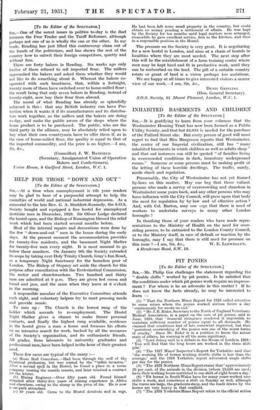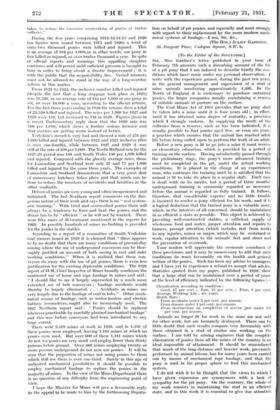PIT PONIES
[To the Editor of the SPECTATOR.] Sra,—Mr. Philip Gee challenges the statement regarding the " double shifts " worked by pit ponies. Is he satisfied that the conditions under which pit ponies work require no improve- ment ? For whom is he an advocate in this matter ? If he does not know the facts already, he may be interested to learn— (1) " That the Northern Mines Report for 1926 called attention to some mines where the ponies worked sixteen hours a day continuously for weeks on end.' (2) " Mr. J. R. Rider, Secretary to the North of England Veterinary Medical Association, in a paper on the care of pit ponies, said in June, 1929, that financial stringency rendered it impossible to maintain sufficient number of ponies equal to all demands. He claimed that conditions had of late somewhat improved, but that persistent overworking of the ponies was one of the worst forms of cruelty.' Since Mr. Rider is in a position to know the actual state of affairs, his warning is all the more significant.
(3) "Lord Joicey said in a debate in the House of Lords in 1928 : You will find that the long hours are worked in the three shift pits.' (4) "The 1927 Mines' Inspector's Report for Yorkshire said that the working life of horses working double shifts is less than the average,' and the 1928 Yorkshire report advocated single shifts per day for the ponies.
(5) "The 1929 Northern Mines Reportstates that approximately 50 per cent. of the animals in the division (where 19,000 are used', have their working hours restricted to one shift of eight hours a day.'
(6) "Pit horses in South Wales have for many years worked nine shifts a week, and sometimes a shift on Sunday as well, although the trams are large, the gradients steep, and the loads drawn by the homes are very heavy in that coalfield.
(7) "The 1929 Yorkshire-Mines Report refers to the official action
taken to reduce the excessive overworking of ponies at twelve collieries."
During the five years comprising 1912-13-14-15 and 1920 (no figures were issued between 1915 and 1920) a total of sixty-two thousand ponies were killed and injured. This is an average of 184 per 1,000, or in other words, one pony in five killed or injured, or over twelve thousand a year. In spite of official reports and warnings this appalling slaughter continues and will persist until sufficient pressure is brought to bear in order to bring about a drastic improvement ; it is with the public that the responsibility lies. Vested interests must not be allowed to stand in the way of a long-overdue reform in this matter.
From 1921 to 1925, the inclusive number killed and injured (despite the fact that a long stoppage took place in 1921) was 51,520, or an average rate of 162 per 1,000 or one pony in six, or over 10,000 a year, according to the official returns. For the last three years ending in 1929 the returns show a total of 22,520 killed and injured. The rates per 1,000 for 1927 and 1928 were 140, but increased to 148 in 1929. Figures given in a recent Parliamentary reply show that the 1930 rate was 160 per 1,000, which shows a further serious increase and that matters are getting worse instead of better.
Yorkshire's record is very bad and showed a rate of 251 per 1,000 killed and injured between 1922 and 1925 inclusive (this is over one-fourth), while between 1927 and 1929 it was still at the rate of 220 per 1,000. The North Midland rate for the 1927-29 period was 188 and South Wales 130 per 1,000 killed and injured. Compared with the ghastly average rates, those for Lancashire and Scotland were only 37 and 77 per 1,000 killed and injured for the same three years. The examples of Lancashire and Scotland demonstrate that a very great deal of unnecessary butchery takes place and that much can be done to reduce the numbers of accidents and fatalities in the other coalfields.
Drivers of ponies are very young and often inexperienced and untrained. The last Northern report comments on the dan- gerous nature of their work and says there is no " real system- atic training." With tired and overworked ponies there will always be a tendency to force and beat the ponies, and the driver has to be " efficient " or he will not be wanted. There were fifty cases of ill-treatment mentioned in the reports for 1929. In possibly hundreds of mines no bedding is provided for the ponies in the stables.
According to a report of a committee of South Yorkshire coal owners issued in 1929 it is claimed that " there appears to be no doubt that there are many conditions of present-day mining where the use of underground conveyors can be thor- oughly justified on account of both saving in cost and safer working conditions." When it is realized that these con- veyors do away with the use of pit ponies, there is even less justification for the existing deplorable conditions. The 1928 report of H.M. Chief Inspector of Mines broadly condemns the continued use of horse and rope haulage in mines and said : " I should like to see it largely superseded by a much snore extended use of belt conveyors ; haulage accidents would thereby be largely eliminated. . . . Accidents in mines are very largely due to the haulage of coal in tubs." Other mech- anical means of haulage, such as motor haulers and electric battery locomotives, might also be increasingly used. The 1927 Northern report said : " Ponies should be replaced wherever practicable by carefully planned mechanical haulage" and this was before conveyors had been introduced to any large extent.
There were 2,419 mines at work in 1929, and in 1,238 of these ponies were employed, leaving 1,181 mines at which no ponies were used. But over 600 of these 1,181 mines which do not use ponies are very small and employ fewer than thirty persons below ground. Over 480 mines employing twenty or snore persons underground do not now use ponies. It will be seen that the proportion of mines not using ponies to those which still use them is over one-third. Surely in this age of unlimited mechanical possibilities it should be possible to employ mechanical haulage to replace the ponies in the majority of mines. In the view of the Mines Department there is no question of any difficulty from the engineering point of view.
I hope the Minister for Mines will give a favourable reply to the appeal to be made to him by the forthcoming Deputa-
tion on behalf of pit ponies, and especially and most strongly with regard to their replacement by the more modern mech- anical systems of haulage.—I am, Sir, &c.,
(The Hon.) JULIET GARDNER.
26 Draycott Place, Cadogan Square, S.W. 3.












































 Previous page
Previous page